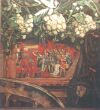|
|
Personages |
|
|
|
 |
Renato
Guttuso
(1912-1987) Painter. His greatest picture portraying Colapesce can be seen on the ceiling of the Vittorio Emanuele Theatre. Guttuso was considered too organic for the Italian Communist Party. Some of his controversial paintings include Il Carretto dei Cavoli e Spes Contra Spem. |
 |
 |
Giuseppe Seguenza
(1813-1889) He was a naturalist a pharmaceutical chemist and a professor at the University of Messina. Seguenza was the author of several studies on the geology of Messina's landscape. |
|
| Bernab˛
Brea
It is considered he biggest archaeological museum in Europe and houses approximately 20,000 pieces. Bernab˛ Brea , the museum founder, thought that the most ancient Sicilian in habitants -the "Siculi"- came from Liguria in northern Italy, while the "Sicani" came from Spain. Another Sicilian ancient people, the "Elimi", have an unknown origin. Recent studies revealed that the "Sicani" had fair eyes and fair hair. |
 |
|
 |
Aristide
Sartorio
After 1908's earthquake, he began designing the mosaics for the Cathedral but was unable to finish due to a serious illness that eventually caused his death. Several of Santorio's designs can be found in Giostra's archiepiscopal seminary. One of his greatest pictures can be seen in Rome's Montecitorio building. |
|
| Maria Grazia
Cucinotta
Actress. She was born in Messina in 1969 and played important roles in several movies, including Troisi's "Il Postino". |
 |
|
 |
Libero
Millimaggi
Giovanni's son who left Messina for several years to follow his father in political exile. Like his father, he was a lawyer and a teacher. In the Italian Republican Party, he was a cultural activist, as well as the director of the Messina film Festival. |
|
| Angelo Musco
(1872-1937) He was a great Sicilian Theatre and film actor. He was born in Catania but loved Messina and in 1920, Musco bought the Messina Grand Hotel and villa in SpartÓ. |
 |
|
 |
Giuseppe La
Farina
(1815-1863) Was a Messina born writer and politician. He was a revolutionary, the Minister of the Kingdom of Sicily, a supporter of the annexation to Italy and a deputy of the Italian Parliament (Cavours agent). He prepared the farce of the plebiscite (narrated by Tommasi di Lampedusa in the "Gattopardo" through his character, Tumeo). The people of Turin consider La Farina their hero. His father was the founder of the "Reading Room" where the September 1, 1847 revolt was organised. |
|
| Sandro
Pertini
(1896-1985) He was the President of Italy from 1979-1983. During a visit to Messina in 1980, Pertini presented the city with a gold medal in honor of the 1943 allied air-raids which resulted in 7,000 dead and missing. On August 17, 1943 the last of the nazi-fascists left Sicily. Americans occupied Sicily during the fall of Fascism. |
||
 |
Tommaso Aloisio Juvarra He was Filippo Juvara's (architect), the King of Naples engraver, nephew. In 1859, he was the Italian Kingdom Engraving institute director and painted the first Sicilian stamp. |
|
| Giovanni
Millimaggi
(1887-1953) He was a lawyer, a teacher. a poet and a communist. An indipendentist, he was called by the Americans after the war. Millimaggi was persecuted by the fascists and was often taken as a political prisoner. He was expelled by the Communist party because Of his critical ideas. He was Libero's father. On March 7, 1947, his brother Spartaco was among demonstrators shouting "Go on Savoia!" and assaulted by the Carabinieri. Giovanni Millimaggi later testified against assailants in the trial. |
 |
|
 |
Consolo
A writer, was born in the province of Messina. Among his masterpieces is "Le Pietre di Pantalica". |
E-mail: baeli@messinacitymap.com